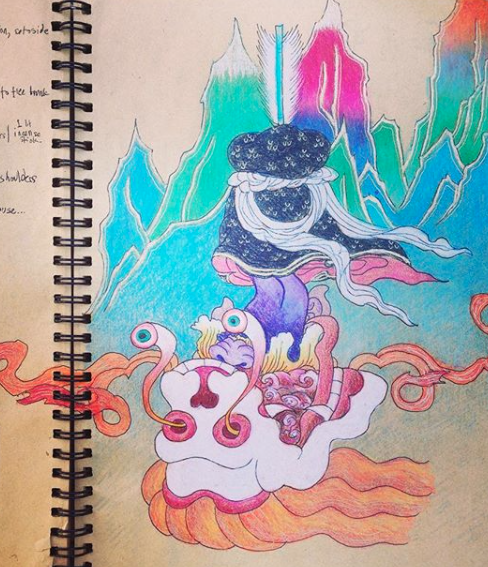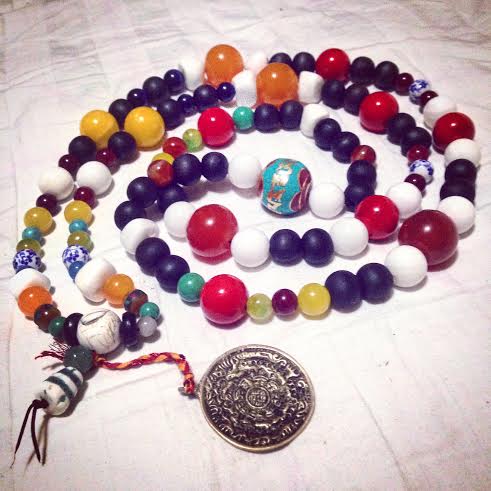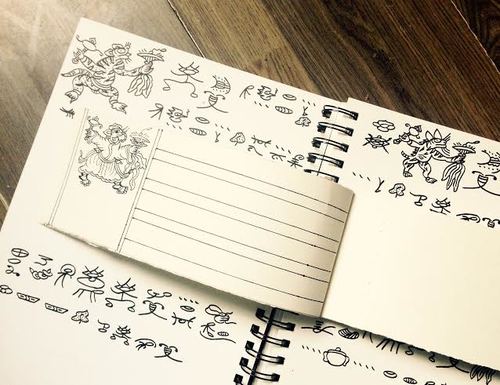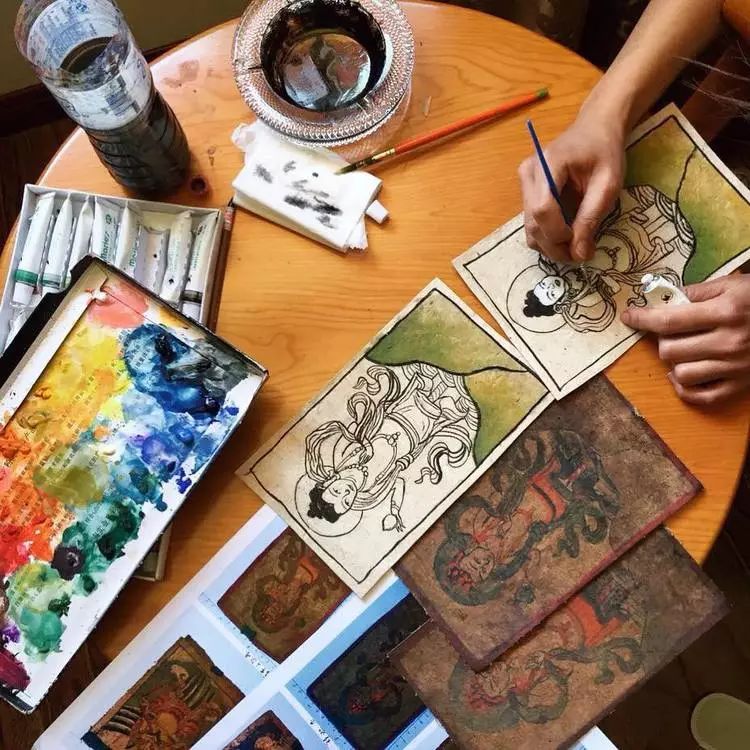WuZhimi transcribes Dongba ritual scriptures in Tacheng Village, using ink and reed pen. (photo: Sarah Wang)
SHAMANIST STUDIES
(2013-present)
1. WUZHIMI (Lijiang, Yunnan, China)
WuZhimi studies as an apprentice Dongba in China's Yunnan Province. Traditionally, only men can become Dongba shaman-priests... but when asked "why?", nobody knows the answer.
This long-term project contemplates themes of: gender in spiritual/ religious practice, gender roles in modern China and its agricultural societies, patriarchy vs. matriarchy, contemporary international shamanism (re: neo-Dongbaism and internet culture), shamanic fractals/ algorithms in societies, sacred wardrobe/ tools/ performance/ ritual, issues of authenticity, and Dongba/ animism in conversation with Christianity (esp. Protestant) / Buddhism (esp. Tibetan+ Mongolian)/ Daoism/ Wicca/ etc.
WuZhimi can be found in Lashihai lake valley and Lijiang City, in the nearby vicinity of Black Dragon Pool.
“Susinabu”- a study from Jiyunsi Temple. (20140913) by WuZhimi
Learning Process
On-site studies in Lijiang/ Tacheng prefectures.
To-Do List: Study written + spoken Naxi language, Dongba symbols, texts, dance choreography. Acquire wardrobe and tools via the same methods as other contemporary Dongba; gradually tailor and customize to your individual measurements/ needs. Study trance/ chants/ songs. Confront, participate in, and analyze traditions of husbandry + sacrifice. Foster knowledge of plants, herbal remedies, TCM, geography. Improve relationships with human communities and natural environments, deepen understanding of elements and their essence(s). Study Dongba entities/ deities/ networks; compare/ contrast with other global belief systems; Agitate existing power dynamics and activate conversations, on local and international levels. Practice daily prayer. Smash demons. Observe traditional rituals, shrine/ altar composition, practice crafts and drawing, replicate teachers' documents by hand. Respond to calls and requests. Introduce Dongba to internet + social media; see what happens.
Learning how to kill and pluck a chicken, with ErGe.
Frequently Asked Question:
Q: Is there an initiation ceremony to become a Dongba? How do you know when you've become one?
A: There is no initiation ceremony to become a Dongba.* Levels and areas of expertise differ for each individual. Traditionally, Dongbas are also part-time farmers, pursuing religious studies at their own pace. Shaman-priests are essentially servants to their communities, and community needs vary by season and geographical location. One Dongba might be an herbal specialist, while another is an expert at mythology and scriptures- for example. A farmer who studies Dongba intensely for three years, might know more than a Dongba who studied sporadically for ten. If their areas of expertise differ, then neither is “better” than the other. A larger-sized ritual requires the combined knowledge of multiple Dongbas with different skills and specialties. They gather a few times before the event to discuss and review general itinerary- such as who will do which parts, how to sing which songs, what ingredients are needed, etc. You know you’re a Dongba once your community recognizes you as one. If you have valuable skills/ services to offer, your environment naturally approaches you with requests.
*Edit (20190906): There is a formal “graduation ritual” (and more recently, levels and tests administered by the Dongba Research Institution at the annual Dongba conference at Jade Water Village), but it is not mandatory to undergo these tests or rituals in order to become a practicing Dongba priest.
Learning choreography for Dongba dance.
2013
Year of the Water Snake
Observational sketches of Ghost House and chicken sacrifice, from the 3-Day Nature God Ritual. Ghost Houses are built as part of rituals, for calling and hosting ghosts, then destroyed and set on fire after the rituals are over.
Ghost House. 2. A cage for “Bad Ghosts.”
Ghost House. 3. An altar for “Good Ghosts.”
A Dongba priest riding on a rainbow, with ax and sword in hands. Copied from HeXiudong’s Dongba ritual cards in Sideng Village, Tacheng.
Xiuqu (a.k.a. Garuda). Master Copy of an original by Mu Cheng. Requested assignment by Dongba HeXiudong. Lines + color: WuZhimi. Ink and color pencil on Dongba paper.
WuXing Bagua in Your Hand: for Divination/ Fortune-telling/ Name-changing purposes. Central point lies in center knuckle of your middle finger. Zodiac animals and elements lie in their respective quadrants. For male requests, move thumb clockwise. For female requests, move thumb counter-clockwise. For non-binary requests, the Dongba does not know how to proceed, because no one’s ever taught him how to do that, but, it’s an important question… // Lesson: Hexiudong / Drawing: WuZhimi
2014
Year of the Wooden Horse
“Llangjyojingjyo”- a dancing warrior deity. Study of original by MuCheng. Requested assignment by Dongba Yanjiahua, who offered to exchange the drawing for a handmade Dongba drum. Now framed and in ritual use in Siding Village, Tacheng, Jade Dragon Snow Mountain. // Line + color: WuZhimi, Cloth framing: YanJiahua.


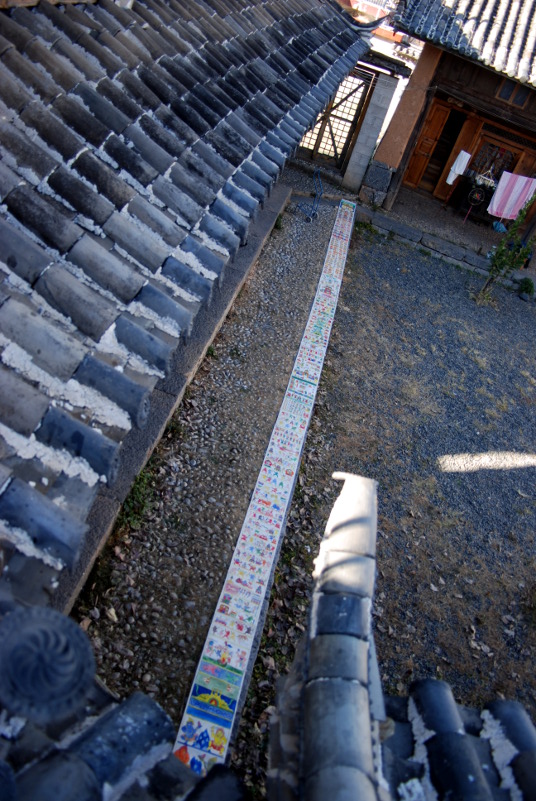

Panel #68 of Road to Heaven (in progress)
20140728: First American Drge // "A Drge is a type of creature that flies in the sky and eats bad things." // Lines: HeXiudong / Color: WuZhimi
Squirrel Funeral
Grave + ceremony for a drowned squirrel
Modest funeral for a defiant spirit. Conducted down the road from Lijiang Studio, at sunset. For details, click: [here]
Chitipati: Skeleton dancers from Jiyunsi Temple (Protectors of Truth)
Dingbashiluo, founder of Dongbaism. // Line: HeXiudong / Color: WuZhimi
Youma (likely the Dongba version of Buddhist Yamantanka) Fierce protector deity who can have different heads. // Line: HeXiudong / Color: WuZhimi
2015
Year of the Wooden Goat
Sites: Baltimore, MD; Brooklyn + Manhattan, NY; Miami, FL; San Juan, Puerto Rico; Managua, Nicaragua; Yunnan, China
Flier Design for the Lesser Heat Festival (by WZM)- featuring the symbol for the Dongba choreography of “Woman Dance,” inside a crown. Made with Dongba paper.
Study: Wedding/ Baby Shower Ritual
“How to Name Your Baby"
HeXiudong’s illustrated chart for altar setting instructions. Top diagram: baby shower ceremony. Bottom diagram: wedding ceremony.
^In the above video, Dongba San is chanting with cymbal as DoBo cleanses altar space with burning pine.
After the cleansing, Dobo takes smoldering pine branches and places it outside. (Sideng Village)
Collected 108 beads to string a Dongba mala necklace ("(ba33 der21)"
Started a Dongba Dance book to catalogue 12 basic Dance choreographies (including the standard Intro Sequence): Gods of the North, South, East, West, Center, Tiger, Dragon, Qilin, Elephant, Xiuqu (Garuda), Flower Dance, and Woman Dance
SayiWeideng (in progress): preliminary carbon tracings (as per request by Dongba YanJiahua)
SayiWeideng (finished): “Highest ranking Dongba God” // Lines: WuZhimi / Color + scroll framing: Dongba YanJiahua. Now used in rituals in Tacheng’s Sideng Village.
Dongba “Naka”, used in ritual ceremonies, represents a place which holds the souls of the dead... Resembling the Mexican "Gods Eye"/ “Ojo de Dios”
















2016
Year of the Fire Monkey
Sites: Yunnan, China; Baltimore, MD; Los Angeles, CA; Khövsgöl+ Töv+ Khentii Provinces, Mongolia; Miami, FL
Flower Crown- a rare design. Meant to be worn by women and children; a different model than the crown worn by men. Center panel: Pancisamei (Goddess who oversees all rituals); L to R: Jade, Silver, Gold, Turquoise. // Lines + binding: Dongba HeXiudong, who says his “grandma had one like this.” Color: WuZhimi
I brought some Sculpey to Tacheng village (Yunnan) to make stuff with the Dongba shamans but they decided that polymer clay sucks, "its no good, too tough, flour+ water is better."
-more videos from this Wind Ritual [here]
Dabba Cards (in progress), commissioned series by the Mosuo Museum. Full report: here.
Dabba Cards. 2. // Photo: M. Hannon
Dabba Banner Cards. // Photo: M. Hannon
2. Shamanism in Mongolia
Investigating traditional Mongolian shamanist places, with support provided by the Asian Cultural Council’s Visual Arts grant. Beginning upon arrival in Ulaanbaatar, then moving up northwards into Khovsgol Lake, before searching eastwards towards Binder Soum.
Original proposal: Link [here] // Visit blog entries [here] and [here].
Durteddagua: study from the Zanabazar Museum in Ulaanbaatar, Mongolia.
Dongba Funeral Scroll. With Sanjaajamts Battseren and other Buddhist monks in Mongolia.
Project completion symbolized by the finished book, “080: The Lucky Punch.” This work was presented at Art Basel Miami later in the year.
2017
Year of the Fire Chicken
Sites: Los Angeles, CA; El Tambo, Colombia; Khövsgöl Province, Mongolia; Yunnan, China
“WuGushen”- a domestic deity //lines: HeXiudong / face+color: WuZhimi
Tracing/ study of a Dongba BeKa crown (actual size, hand for reference). Purportedly “for men only,” because if a woman wears it, she resembles the pictographic symbol for a certain kind of demon…
HeXiudong’s custom BeKa crown, made of welded steel, with falcon feathers and porcupine quills. To be worn as an innermost layer, behind the 5-Panel Crown, and over his homemade felt-and-bamboo hat.
Study: Exorcism Ritual
Ceremony requested by a urban Lijiang family (formerly farmers) with multiple strange deaths in family and inner circles. The entire process took approximately 12 hours of preparation (in the daytime) and 12 hours of actual ritual-facilitation, including the sacrifice of one goat and two chickens past midnight. We finished and headed home shortly before dawn.



Dough Figurines, for rituals. Pictured here is 1 example out of a total of 25 learned (over the course of 3 days). Workshop taught by Dongba HeXiudong, two students in attendance.
Ingredients for a Rain Ritual (for a drought in Los Angeles)- requested by my mother, and advised over WeChat by Dongbas HeXiudong and YanJiahua. We sourced local plants from the backyard, and food from the kitchen, but the rhododendrons- a necessary ingredient for the ritual- we had no choice but to buy from the nearest Home Depot warehouse garden. A week later, it did rain.
Dabba Deer, painted on a denim jacket.


2018
Year of the Earthen Dog
"My first day in Berlin, I was sent off to an appointment at the Staatsbibliothek zu Berlin (State Library) to see the old Dongba ritual texts they have in their special collections vault- texts that Joseph Rock bought and sold. I had to show my passport and then step into an enclosed area with clear walls and remote locking door. I asked the librarian if I could copy the texts, and she said ‘Copy machine? No!’ and I said ‘Not machine, by hand,’ and she laughed ‘Oh yes that's fine, but with pencil only.’ So I took notes and copied 7 covers in about 4-5 hours. After I finished, I held up my phone to take photos for reference records, but then a 2nd librarian rushed over to scold me saying ‘No no no! No photos! You must sign contracts first!’ then made phone calls and pulled paperwork for me to fill out. I had already made these copies by hand but apparently that's not a problem. What's the difference between photos and drawing in this context?”
From the “Art/ Community/ Art” Symposium (Berlin, Germany)
Presentation of the funeral scroll (Berlin, Germany) // Photo: Alfred Banze
ZhaNguoko: “Reincarnation Window”- from the Road to Heaven scroll. // Lines: HeXiudong / Color: WuZhimi
Optical Illusion Tapestry, which HeXiudong says is also the ZhaNguoko. // Painting: WuZhimi
“YiDaWeiBo: a Lucky Thing” // Lines: HeXiudong / Color: WuZhimi
Lijiang Library Exhibition: Road to Heaven 3
[alternative subtitle: A Practice-Based Approach to Theology]
(October 12-28th, 2018) // Link to blog entry: [here]
an exhibition of work by Frog*
Co-produced by Dr. Petra Johnson and HeJixing
LEUS 2019
From the blog: “(Jan 12-14): Hohhot, Inner Mongolia, I will be presenting a 20-minute talk at the Landscape Ecology and Urban Sustainability Conference. On Sunday 13th around 3pm I’m scheduled to share my slideshow on ‘Navigating Contemporary Ecological Concerns via Traditional Dongba Approaches.’”
As of April 2020: Interested in food justice, herbalism, TCM, biological roles of artists, musicians, and healers within their communities, paganist rituals as adapted for modern/ urban/ North American contexts… All of these relevant translations and iterations to the study of traditional shamanist forms and functions. Updates soon.
(Last updated: 20200407)


